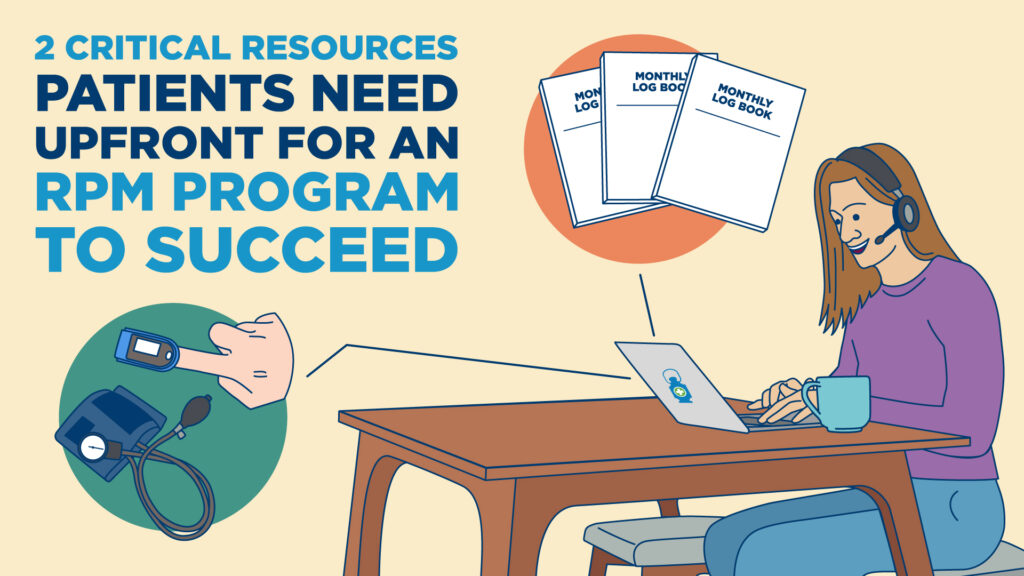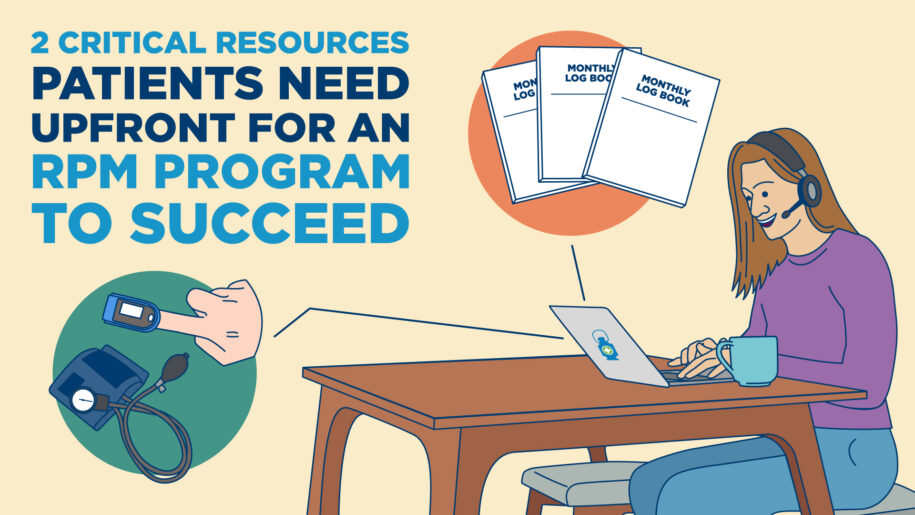
2 Critical Resources Patients Need Upfront for An RPM Program to Succeed
If your hospital, clinic or healthcare facility provides care to patients with chronic conditions, remote patient monitoring (RPM) can help improve your patients’ outcomes and overall engagement.
The simplest way to describe RPM is that it is chronic care management (CCM), just enhanced by a remote monitoring device. In that sense, RPM is a robust means of providing high-impact CCM to patients, especially those on Medicare plans. There are many components that make up a successful RPM program; however, before a patient even takes their first reading with a remote monitoring device, it’s important that your patients are provided with the right resources upfront to set you up for success.
In this blog, we’ll discuss how two critical resources — educational materials and log books — contribute to the success of a remote patient monitoring program by ensuring a smooth and seamless experience for your patients during setup and onboarding.
1. Equipping Patients to Participate in RPM with Educational Materials
When providing RPM to patients, it’s critical that they have resources on hand to understand why they are receiving specific care, how it will contribute to their health outcomes, and how to operate the tools effectively. These materials can include:
- Medical condition and symptom guides
- Simple, visual setup & troubleshooting instructions
- Visual best practice guides to help minimize false alarms
- Acceptable range of clinical parameters, including clear instructions on what to do and who to call when readings are out of bounds
Most likely, many patients are new to remote patient monitoring tools like blood pressure cuffs, weight scales and pulse oximeters. However, accurate data reports are necessary for healthcare providers to administer optimal care to remote patients. Having simple and visual educational materials on hand ensures patients are adhering to best practices and that the data reported to your clinical team is accurate. It also allows patients to take control of their own health — even when they’re not at a healthcare facility or in immediate contact with a nurse.
RPM Tool Troubleshooting Support
Educational toolkits and material packets can also help patients troubleshoot simple technological errors.
For instance, if an automated blood pressure cuff is not taking readings because the patient forgot to press a button or toggle a switch on, problem-solving with an on-hand setup guide can be more efficient than calling the provider’s office or a nurse care manager.
As a result, accurate and timely data is reported to healthcare providers, who can then use the information to provide timely and proactive patient interventions.
Prompt Management of Adverse Conditions
More importantly, educational materials can empower patients to detect unusual physiological results immediately, before symptoms develop adversely.
For example, a patient who notices abnormal blood pressure readings can immediately reach out to their nurse for prompt intervention before the condition worsens. Rapid intervention is particularly critical for patients in remote locations who might not immediately have access to a nearby emergency room or urgent care facility.1 And while the out-of-bounds readings would trigger a follow up from the patient’s clinical team, this keeps patients engaged and informed during situations when the clinical team is not available (e.g., outside normal office hours).
2. Tracking Data and Increasing Patient Engagement with Log Books
The success of an RPM program depends heavily on the quality of data transmitted from patients to their providers or nurse case managers, and the frequency the patient takes their readings (for instance, having no data is just as problematic as having bad data).
Receiving frequent and accurate data translates into more reliable clinical decision-making, especially when tracking patients’ progress over time to identify unusual changes that require an immediate follow-up.
All this of course goes without saying, but in order to receive frequent and accurate data transmission to your clinical team, the patient must be engaged in their care.
It’s no secret that you absolutely must have dedicated care management in an RPM program to keep patients engaged, but another simple way to improve engagement in an RPM program is to encourage patients to log physiological measurements weekly or monthly using RPM tools and logbooks. That said, logging data for RPM decision-making must work hand-in-hand with patient education.
Log books should come with an educational toolkit, which may include tips for how to use the device or record data and what to do if abnormal data is reported. Oftentimes, these are in the form of checklists or infographics.
Benefits of Using Log Books for RPM
The simple act of writing down their own readings each time can help to increase downstream success in your RPM program in many ways, including:
- Patients are more engaged and hold themselves more accountable
- Patients become more educated on best practices over time, resulting in fewer false alarms
- Patients are more prepared for calls and office visits with your clinical team
- Patients will have their own copy of the data to share if they see an outside specialist that cannot access your EMR, such as a cardiologist, endocrinologist, etc.
Depending on the data collected by the RPM device, patients can also learn which activities, food or related factors influence changes in their physiological condition.
For instance, a log book for a pulse oximeter typically includes fields for the:
- Oxygen concentration reading
- Date and time of the reading
- Pulse at the time of the reading
- Activity level for that specific day
A simple analysis of these patterns and their associated outcomes can help the patient learn more about which factors contribute to changes in oxygen saturation. Patients can then discuss these patterns with their healthcare provider and amend their care plan as needed.
When setting up a remote patient monitoring program, you will likely need to consider the role of patient education in influencing the care you provide, and, ultimately, how you will bill under Medicare. That’s where RPM expertise comes in.
Automated and Robust RPM Support with Signallamp
In addition to personalized, dedicated nurse care management, RPM tools like educational resources and log books are just a few of the critical resources we provide to you and your patients as we help you to administer proactive, sustainable remote chronic care to your patients at scale.
Signallamp’s end-to-end RPM solution, combined with sustainable tools and proven enrollment processes, allows your team to collect reliable data and provide timely interventions to your patients, preventing unnecessary complications or hospitalizations.
Schedule a consultation to learn more about our remote patient monitoring services, including how we can help you to sustainably scale a successful RPM program with zero upfront or out-of-pocket expense.
- HHS. Telehealth and Remote Patient Monitoring. https://telehealth.hhs.gov/providers/preparing-patients-for-telehealth/telehealth-and-remote-patient-monitoring/

